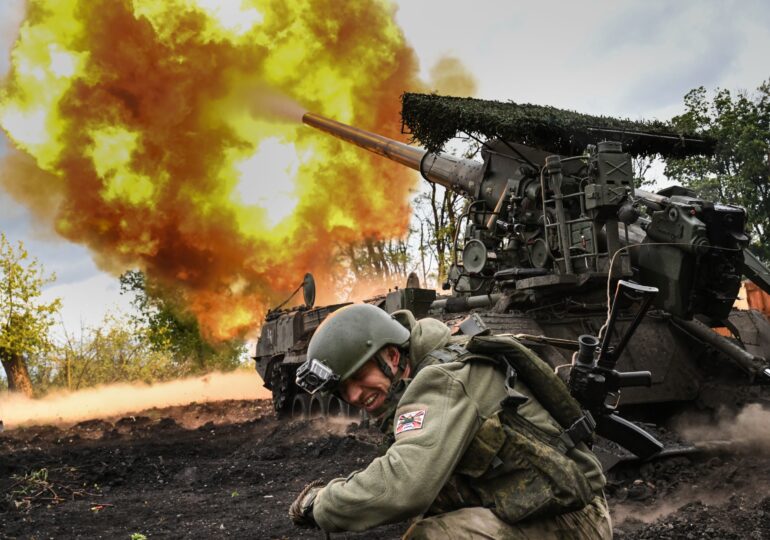A pungent smell hovers over the town of Rodynske. A few minutes after entering the town, we see the source: a 250 kg bomb has destroyed the main administrative building and damaged three residential blocks.
Although a day has passed, the debris is still smoldering. From the edges of the town, artillery fire and gunshots can be heard – Ukrainian soldiers are shooting down drones, report the BBC journalists on the front line in Ukraine.
Rodynske, on the front line
Rodynske is only 15 km north of the city of Pokrovsk, where Russia has been trying to advance from the south since last autumn. So far, Ukrainian troops have managed to halt the advance, but Moscow has changed tactics: they are now trying to encircle the city and cut off supply lines.
In the last two weeks, parallel to the failure of international negotiations for a ceasefire, Russia has launched a rapid offensive, with the most significant territorial gains from January to date. Rodynske is clear evidence of this intensification of fighting.
Russian drones, getting closer
Shortly after our arrival in the town, a Russian drone flies over the area. We take refuge under a tree. Another drone explodes nearby.
The sharp noise of one of the deadliest weapons of war accompanies us for minutes on end. When we no longer hear it, we run towards an abandoned building 30 meters away.
The fact that drones fly freely over Rodynske indicates that the Russians are operating from much closer positions than previously known. Most likely, from areas recently captured along the road linking Pokrovsk to Kostyantynivka. When we emerge from shelter, we see thick smoke at the edge of the road - probably a downed drone.
Towns in the rear are no longer safe
We arrive in Bilytske, a bit further from the front line. Here, a row of houses was destroyed by a rocket strike. One of them belonged to Svetlana.
"It's getting worse by the day. The explosions used to be far away. Now they hit us directly," says the 61-year-old woman. Her luck was that she wasn't home.
In a safe shelter, outside the drone range, we talk to artillerymen from the 5th Assault Brigade. "You can feel the intensification of Russian attacks: rockets, mortars, drones - they use everything they have to break our supply lines," says Serhii.
His unit has been waiting for three days for favorable weather conditions to move without being detected by drones.
Unjammable drones
The latest threat comes from fiber optic drones. These have a cable attached to the pilot's remote control. The video and control signal is transmitted through this wire, not through radio frequencies - making them impossible to jam, explains Moderator, a drone engineer from the 68th Mountain Hunters Brigade.
At the beginning of the war, both armies relied on electronic jamming to neutralize drones.
The new fiber optic models eliminate this vulnerability. Russia started using them long before Ukraine.
"We can maneuver them at low altitudes, even inside buildings, to search for targets," says Venia, a drone pilot.
Although slower and more obstacle-sensitive like trees, these drones make even simple movements on the front line extremely dangerous.
"When you enter a new position, you don't know if you've already been spotted. And if you have, maybe you're living your last hours," says Oles, a reconnaissance sergeant. That's why soldiers spend more and more time in positions.
Days without sleep
Infantrymen in trenches, like Oles and Maksym, can rarely speak to journalists due to the risks. In a rural house turned into a temporary base, Maksym says, "I've spent the most 31 days on the front line. Others have even done 120. Before drones, rotations lasted 3-7 days."
Sometimes they don't sleep for three days in a row, in constant alert.
Oles explains the enemy's change in tactics: "Now they come one or two at a time, sometimes on motorcycles or ATVs. Sometimes they manage to sneak in." The front line is no longer a clear line, but a dangerous mosaic, like a chessboard. Advances become hard to measure, and battles are more unpredictable than ever.
Ukraine's resilience put to the test
Even though Russia has gained ground, the conquest of the Donetsk region remains distant. Ukraine is struggling to resist but depends on a constant flow of weapons and ammunition.
As the war enters its fourth summer, the lack of personnel becomes evident. Most soldiers were conscripted after the war started and are learning everything on the go.
Maksym used to work in a beverage company. I asked him how his family is coping.
"It's hard, very hard. They support me, but I have a two-year-old boy, and I hardly see him at all. At least we manage to see each other on video." His voice breaks, tears fill his eyes. He is a soldier of Ukraine but also a father who misses his child.

